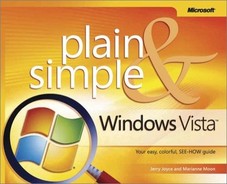Networking, once a requirement only in large corporations, is now almost a necessity in a multi-computer household, a home office, or a small business. With two or more computers connected, you can access files and folders on other computers that have been set up for sharing, and you can share the files and folders on your computer with other people, either in Public folders or directly from your computer. If there are items to which you want to limit other people’s access—your private files, for example—you can do so. If you’re working from home, you can easily connect to your office network by creating a VPN (Virtual Private Network), which ensures a secure connection to a computer on the network.
When you’re away from your workplace, Windows Vista recognizes the wireless networks that are within range—some of which are open and free, and others that ask for a security key or a passphrase before you can connect wirelessly. If you don’t have a network, you can still connect using an ad hoc, or improvised, network. Using Windows Meeting Space, you can hold virtual meetings, with up to ten participants, and you can send invitations to the meeting via e-mail and provide handouts in the form of shared files. There’s even a network projector you can use for PowerPoint presentations or other types of demonstrations.
When your computer is connected to a small home or business network, and when other computers on the network are set up to share items, you can connect to a computer on the network and access items on that computer. The type of access you have to the contents of another computer depends, as it should, on the sharing settings on that computer to ensure that private files are kept private and public files are made available. Although networking is easiest between computers that are running Windows Vista or Windows XP, you can still connect to computers running other types of operating systems, provided those computers are properly configured.
 Click the Start button, and choose Network from the menu to display the Network window.
Click the Start button, and choose Network from the menu to display the Network window. Double-click the computer whose files or folders you want to access.
Double-click the computer whose files or folders you want to access. If the Connect To dialog box appears, enter a user name and password for that computer, and then click OK. The user name and password must be those that have been set up on that network computer.
If the Connect To dialog box appears, enter a user name and password for that computer, and then click OK. The user name and password must be those that have been set up on that network computer. Double-click a folder to access its contents. Use the folder and the contents as you would any other folder, depending on the type of permission you’ve been granted.
Double-click a folder to access its contents. Use the folder and the contents as you would any other folder, depending on the type of permission you’ve been granted.
See Also
"Sharing Your Files over the Network" for information about setting password-protected sharing.
See Also
"Adding a Link to a Folder" for information about adding a folder to the Favorite Links list in the Navigation pane of your folder windows.
"Creating a Connection to a Network Folder" for information about creating quick access to a folder using a drive letter for compatibility with some programs.
Tip
Windows Vista shows all the computers that are on a network, but Windows XP shows only the computers that are in the same workgroup. To see all the computers on your network from a computer that’s running Windows XP, set the same workgroup name for all the computers. To see or change the name of the workgroup you’re using on your Windows Vista computer, click System And Maintenance in the Control Panel, and then click See The Name Of This Computer in the System Section to open the System window.


